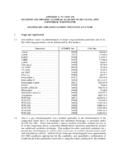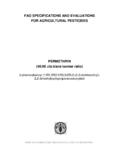Transcription of The impact of herbicides on weed abundance and ...
1 The impact of herbicides on weed abundance and biodiversityPN0940 IACR - Long Ashton Research Station & Marshall Agroecology LtdDr Jon MarshallMarshall Agroecology Limited, 2 Nut Tree Cottages, Barton Winscombe,North Somerset, BS25 : University of ReadingProfessor Valerie BrownCentre for Agri-Environmental Research (CAER), Department ofAgriculture, University of Reading, Earley Gate, Box 236, Reading,RG6 : YorkDr Nigel BoatmanCentral Science Laboratory, Sand Hutton, York, YO41 : RothamstedDr Peter LutmanIACR- Rothamsted, Harpenden, Hertfordshire, : Crops Research InstituteDr Geoff SquireScottish Crop Research Institute, Invergowrie, Dundee, DD2 : The impact of herbicides on weed abundance and biodiversityPN0940 ContentsPageAcknowledgementsEXECUTIVE SUMMARY AND CONCLUSIONS1.
2 Policy Scope of the Desk Target and Non-Target Plant ( weed ) Species22. ECOLOGY OF REPRESENTATIVE weed SPECIES73. UPDATING PN0923 - NON-TARGET EFFECTS OF Is biodiversity Important? Change in weed Communities Impacts of Interactions Between weed Diversity and Non-Target Effects Within the Non-Target Effects Beyond the Genetically Modified Herbicide Tolerant (GMHT) Spatial Distribution, Remote Sensing and Mapping of Farming Systems174. CHANGES IN ABOVE-GROUND weed ABUNDANCE185. NON-TARGET weed SPECIES IN THE SEEDBANK24GR Squire, Status Of The Non-Target abundance And Dynamics Of The Non-Target Suppressive Management Falling Relaxing Management Rising Community Features And The Potential For Dynamics Modelling Linking Trait to Community through Conclusions336.
3 CURRENT weed CONTROL AND ITS IMPACT34 PJW Lutman, Arable Cropping Herbicide Use in Principal Changes in Herbicide Use Between 1974 And Changes in weed Susceptibility to herbicides Between 1974 and Changes in Timing of Control of Weeds on weed Species Effects Of Fertilisers On weed Overall Conclusions487. EFFECTS OF MANAGEMENT OTHER THAN herbicides 62ON FARMLAND Habitat Fertilisers And Nutrient Cropping Practices638. THE impact OF herbicides ON INVERTEBRATES64VK Brown, Ecological Invertebrate Attributes Of weed Communities Important To Effects of herbicides on By Habitat By Prey By Plant Food New Effects Of herbicides On Soil Sub-Lethal Effects Of herbicides On Invertebrates819.
4 RELATIONSHIPS BETWEEN WEEDS, herbicides AND BIRDS90ND Boatman, The Diet Of Farmland Relationships Between Food abundance And Bird Relationship Between Breeding Performance And Population Relationship Between Adult Mortality And Population Relationship Between Food Density And Other Causes Of Bird Conclusion10210. RISK ASSESSMENT FOR NON-TARGET PLANTS 108 WITHIN CROPS11. PRACTICAL weed CONTROL, biodiversity 112 AND RISK weed Control And Risk Management And Avoidance11412. KNOWLEDGE GAPS AND RESEARCH Weeds And weed Priority Research Areas122 EXECUTIVE SUMMARY AND CONCLUSIONS 123 REFERENCES125PN0940 AcknowledgementsWe wish to thank Dr Lena Ward and the Centre for Ecology and Hydrology for access tothe Phytophagous Insect Database and for useful also wish to thank staff of the Pesticides Safety Directorate for their useful input intothe project, particularly Paul Ashby and Tim Godson.
5 Ingrid Meakin and other staff of theChief Scientists Group were also particularly helpful, including finding meetingaccommodation under trying circumstances while moving also thank colleagues in our own institutions for their input, without whom thisdocument would not have been as wide-ranging as it is. This report has been achieved injust over four months. While there is undoubtedly scope for further work and there are anumber of gaps within the report, it provides a timely review of the impact of herbicides inthe arable SUMMARY AND CONCLUSIONSIn considering non-target plants within arable fields, the majority of plant species that arefound are of only minor concern to farmers, unless present at high population horticultural conditions, it can be argued that all weeds are targets, providing somedifficulty for formal risk assessment.
6 In arable, there are a number of key weed speciesthat are typically controlled irrespective of density. In contrast, rare arable weeds mayrequire specific conservation protection; these species may be non-targets under almost allconditions. The majority of species usually present can be both targets and non-targets andare most likely to be of greatest significance for biological diversity within fields, as theyoccur frequently and with moderate on farmland birds and invertebrates indicate that there have been significantreductions in populations and ranges over the past thirty years. In the case of the greypartridge, there is good evidence that herbicides have played a significant role in theirdecline.
7 Whilst habitat loss and fragmentation may play a role in bird declines, theevidence indicates that habitat degradation is of greater importance. Changes in farmingpractice in general are the cause of most population declines of farmland birds. Whilst theexact causal links are not known for most species, herbicides are review has shown that there have been changes in weed assemblages over the pastcentury, with some species becoming less common, other increasing in frequency andothers remaining static. Studies of weed seed banks indicate little change in weed seedabundance or a slight trend for reduced densities. Where weed control has been relaxed,either as set-aside or where herbicide use has been halved, weed seed banks can increaserapidly.
8 However, the commonest and most competitive weed species tend to become themost abundant, under these conditions. Rare species may not changes in cropping and herbicide use, the move from spring to winter croppingsince the 1970s has been a dramatic change in cropping practice. Co-incident with thechange to winter cropping, there have been major changes in the pattern of herbicide the 1970s, herbicides were used primarily for broad-leaved weed control and on onlyabout 50% of fields. Today, herbicides are used on most fields and are targeted on grassweeds as well as dicotyledonous species. An examination of the weed spectra controlledby the herbicides in use over the past 25 years indicates that on average today s herbicidescontrol more weeds.
9 Broader spectrum products were introduced in the early other than herbicides may play an important role in changing weed assemblages,particularly fertilisers and cropping collected from the literature and from the Phytophagous Insect Database demonstrateclose links between invertebrates and a range of representative weed species. Differentweed species support differing numbers of insect herbivores, with some species hostingnumbers of rare species, as well as pest species. The data indicate that a number of weedspecies that are particularly important for insect biodiversity in the arable habitat can on the use of weed species by birds has also been examined. Whilst, as with theinvertebrate data, there is some lack of quantitative information on preferences, it is clearthat bird species of conservation importance utilise particular genera of weeds.
10 Thus it ispossible to identify genera that are of greater importance for farmland data indicate that herbicides , by controlling weeds and modifying abundance andspecies assemblages, have impacted on wildlife in arable land. These non-target effectsneed to be considered for regulatory reasons, particularly with the requirements under EURegulation 91/414. With such dramatic changes in biodiversity , there are also calls formore sustainable production methods. The challenge will be to grow crops and maintainan appropriate population of weed species to support farmland wildlife. Underhorticultural conditions, this may be difficult, in terms of crop quality , under arable and horticultural production, there may be opportunities todevelop sacrifice areas, such as conservation headlands, or to develop much greaterselectivity of herbicide action, either through selective chemistry or application or acombination of terms of regulatory needs, the approach of selecting representative weeds and assessingtheir importance for biodiversity has been successful.

















